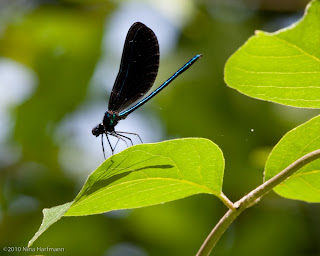“The prothonotary has returned!” he said.
But as I stepped onto the wooden-planked path looping the lake at our local nature center, the excitement this announcer had hoped to read on my face as he joyfully told me of his discovery was clearly absent.
I didn’t know this bird and, although I might have been able to conjure up a vague image in my mind from browsing the plates of warblers in my field guide, the proclamation of its presence there meant little…to me.
Years later, I would learn this bird while walking one summer afternoon on another wetland boardwalk, deeply shaded and winding between tall swamp cottonwood trees that stood in several inches of water.
A ringing call had stolen my attention from the black-winged damselflies that were knitting up the frayed edges of a patch of sunlight--a brief, bright spot in the darkened, wet woods. The song's source had eluded me, though, for quite some time, as I stood peering past the thick, leafy cover where a small bird restlessly flitted, low to the ground, foraging close to the water’s edge.
Eventually, I matched both sound and sight to the boldly yellow-colored warbler in my field guide--the Prothonotary.
An afternoon’s shelter from the strong light and heat of July and my pursuit of ebony jewelwings had given me a life bird, time to stand and watch it work this wetland habitat, time to soak in the rich sound as it spread across the water, golden as the bird from which it flowed.
For the remainder of that summer, I found prothonotary warblers everywhere.
From beside every lake that I canoed,
every quiet river that I kayaked,
every river-rimmed trail that I hiked, I found the song and it followed me--and often, gave a glimpse of the golden bird--until I knew it well and understood the joy of finding its return.
This summer I walked again on the wetland boardwalk where I’d first found my prothonotary warbler, though this time it was butterflies that were on my mind—Baltimore Checkerspots.
In the sunny meadow, a handful of the uncommon flutterbys skipped, barely stopping to nectar
before whisking past and out of camera range.
Pleased that I’d timed my visit to find them flying, yet discouraged that in their flying, I saw so very little of them, I wandered slowly back along the boardwalk to the point where it passed into the darkened cottonwood swamp once again.
A small flock of cedar waxwings crossed the cattail marsh and landed just overhead, lining up shoulder-to-shoulder on the graceful branches of several small willows. Dragonflies paused in the sunshine of the wooden boards, then rose to course above its sedge-filled edges and tall reeds just out of reach of 2 green frogs sitting neck-deep and motionless in the cool water of the fen. Their watchful eye, for this moment, had turned to the northern water snake gliding silently behind them.
Yes, everything about this picture of a still, wooded wetland should suggest a prothonotary warbler. And, if the mangrove forests of coastal Central and South America had sustained him for the winter, the bird I found last year would be back to breed here once more.

Through the darkened woods, across the water that stretched between the cottonwood trees, came the resounding call—clear and bright as the little bird behind it. And, in knowing the bird, hearing his song as I’d heard it before in the very same spot along the trail, my heart made just a little extra beat.
No one felt it but me.
“The prothonotary had returned!”
The Prothonotary Warbler, Protonaria citrea, breeds in hardwood swamps and forested lakeshores of the southeastern United States and is named for the scribes (prothonotaries) in the Roman Catholic Church who wore golden, hooded robes. Dubbed the Golden Swamp Warbler by John James Audubon, it is the only eastern warbler to nest in tree cavities, often using the excavated holes of Downy Woodpeckers and building mossy nests in trees near or over standing water.
Adults forage in low foliage for aquatic insects, snails, flies, beetles and spiders.
Because the prothonotary warbler is extremely habitat specific, habitat loss (wooded wetlands in the southeastern US and mangrove swamps of Latin America) may cause this species to decline.
 No matter where you might be on the birding curve—whether you’ve learned the prothonotary’s ringing call or have never even heard of such a bird, whether you’ve mastered all the species’ migration routes or are still fumbling to find the focus wheel of your binoculars—the Midwest Birding Symposium has something in it for YOU!
No matter where you might be on the birding curve—whether you’ve learned the prothonotary’s ringing call or have never even heard of such a bird, whether you’ve mastered all the species’ migration routes or are still fumbling to find the focus wheel of your binoculars—the Midwest Birding Symposium has something in it for YOU!
There’s no better way to improve your skills, than to put yourself smack in the middle of a bunch of better birders—experts who are passionate about sharing something they love with another and super-nice folks who fondly remember exactly where they were when someone showed them their first life birds.
It’s not too late to get registered.
You’ll be surprised how much fun birds and birders can be!
I’d love to see you there!





































%20copy%202.jpg)


















10 comments:
Hi Nina
Another lovely post. It seems Cedar Waxwings are everywhere at present and your shot of the Baltimore Checkerspot butterfly
was magnificent. I am happy that you found your Prothonotary Warbler the picture is lovely and your story a good reminder of how when we look for one thing we often find another if we are open to it.
Regards
Guy
Nina,
Good find the Baltimore Checkerspot. I happened into some several years ago in TN. Enjoyed this post.
Birding can indeed take unexpected turns (or is it terns ?). My first Prothonotary came at a fen, but only after some persistent squeaking that eventually brought forth Mr. & Mrs. P seeking out the source of the squeaks on the boardwalk.
That is in stark contrast to my first Western Tanager that flew out of nowhere and perched on the railing of a deck outside of the room where I was in conversation with a friend -- and in eastern PA -- far from the usual range of this colorful bird.
In the first case, the bird appeared where expected : in the second , it could not have been more unexpected.
...I'll see you there, Nina! I'm registered and looking forward to the trip. I loved the last symposium.
Nice post! The title caught my attention. Prothonotary Warblers are a rare sighting in Connecticut.I saw exactly one.
Marvelous post. It reminded me of some wonderful experiences with prothontary warblers. I'm an avid paddler and love swamps and bayous with swampy sides the best. Once in south Louisiana, while paddling a lovely wooded bayou, I met a huge group of migrating prothonatory warblers. There was one about every ten feet along the bayou, most calling their clear Sweet, sweet, sweet calls.
Another awesome experience was on the Angelina River, just before its confluence with the Neeches in east Texas. I paddled into a little open pond from the river and saw a orothonatory warbler fly to the top of a broken branch, hanging by a small strip of bark and only a few feet above the water. When it left, I paddled over and looked down to see looked down to see four tiny red mouths gapping in a nest inside the rotted branch.
I'm volunteering at Anahuac NWR on the upper Texas coast and got to lead bird walks the day our new refuge headquarters opened. It is on a parcel of land that the county used for enviornmental education and consists of a mixed East Texas forest that ajoins a cypress swamp. There is a boardwalk that goes through the swamp to the edge of Lake Anahuac. I was able to let everyone see and hear the prothonotary warbler during each walk. We missed seeing the eagle, although he did fly over the headquarters several times that day.
Wonderfullpost and fotos,best regard from Belgium, and having wonderfull walking this summer month.
Those yellow birds are so cute. it reminded me of my two yellow lovebirds.
I envy the wealth of knowledge you hold within. And I so enjoy your lessons and your walks in nature.
Coincidentally, I recently wrote a biography on a Canadian naturalist, Mary Majka, who used to have a TV show for children in the 60s called, Have you Seen? The way you teach and share nature's stories reminds me of her.
Very sweet post, Nina. Wish I could come to the symposium but it is during the exact same time that my son will be visiting me after his safe return from a year spent fighting the war in Afghanistan. I hope you have fun. Maybe I can go next year.
Post a Comment